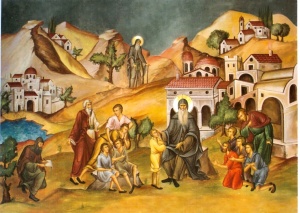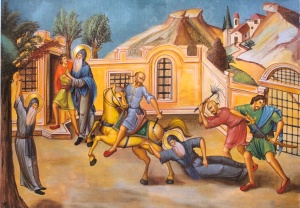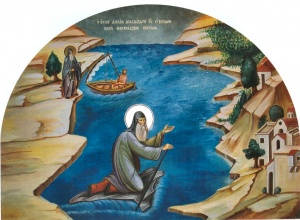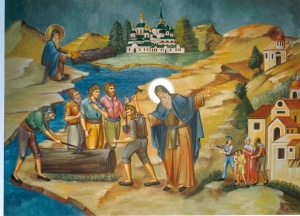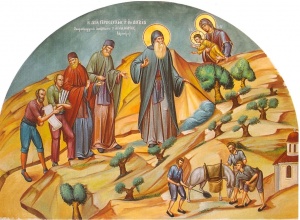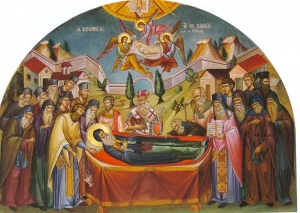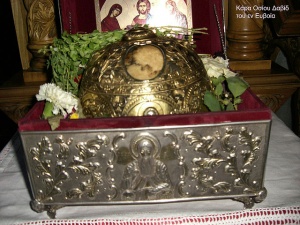ΕΛΛΗΝΙΚΑ αμέσως μετά το αγγλικό
Saint Artemios, the Great Martyr of Antioch (from here)
 He was a prominent military leader
during the reigns of the emperor Constantine the Great (May 21), and his
son and successor Constantius (337-361). Artemius received many awards
for distinguished service and courage. He was appointed viceroy of
Egypt. In this official position he did much for the spreading and
strengthening Christianity in Egypt. He was sent by the emperor
Constantius to bring the relics of the holy Apostle Andrew from Patras,
and the relics of the holy Apostle Luke from Thebes of Boeotia, to
Constantinople. The holy relics were placed in the Church of the Holy
Apostles beneath the table of oblation. The emperor rewarded him by
making him ruler of Egypt.
He was a prominent military leader
during the reigns of the emperor Constantine the Great (May 21), and his
son and successor Constantius (337-361). Artemius received many awards
for distinguished service and courage. He was appointed viceroy of
Egypt. In this official position he did much for the spreading and
strengthening Christianity in Egypt. He was sent by the emperor
Constantius to bring the relics of the holy Apostle Andrew from Patras,
and the relics of the holy Apostle Luke from Thebes of Boeotia, to
Constantinople. The holy relics were placed in the Church of the Holy
Apostles beneath the table of oblation. The emperor rewarded him by
making him ruler of Egypt.
The emperor Constantius was succeeded on
the throne by Julian the Apostate (361-363). Julian in his desire to
restore paganism was extremely antagonistic towards Christians, sending
hundreds to their death. At Antioch he ordered the torture of two
bishops unwilling to forsake the Christian Faith. During this time, St
Artemius arrived in Antioch and publicly denounced Julian for his
impiety. The enraged Julian subjected the saint to terrible tortures and
threw the Great Martyr Artemius into prison. While Artemius was
praying, Christ, surrounded by angels, appeared to him and said,
“Take
courage, Artemius! I am with you and will preserve you from every hurt
which is inflicted upon you, and I already have prepared your crown of
glory. Since you have confessed Me before the people on earth, so shall I
confess you before My Heavenly Father. Therefore, take courage and
rejoice, you shall be with Me in My Kingdom.”
Hearing this, Artemius
rejoiced and offered up glory and thanksgiving to Him. On the following
day, Julian demanded that St Artemius honor the pagan gods. Meeting with
steadfast refusal, the emperor resorted to further tortures. The saint
endured all without a single moan. The saint told Julian that he would
be justly recompensed for his persecution of Christians. Julian became
furious and resorted to even more savage tortures, but they did not
break the will of the saint. Finally the Great Martyr Artemius was
beheaded.
His relics were buried by Christians.
After the death of St Artemius, his prophecy about Julian the Apostate’s
impending death came true.
St Artemius is invoked by those suffering from hernias.
Saint Matrona of Chios (from here)
Saint Matrona of Chios (also called "Saint Matrona
Chiopolitis") was born during the 15th century in the village of
Volissos on the island of Chios, Greece. This is the same village in
which St. Markella was martyred in 1462. The Church celebrates her memory on October 20, and the finding of her head on July 15.
Saint Matrona was born in the village of Volissos on Chios sometime
in the fourteenth century. Her parents, Leon and Anna, were highly
respected and well-to-do Christians. Mary was the youngest of seven
children. From her youth, she showed an interest in monasticism. When
the time came for her parents to arrange her marriage,
she refused because she wanted to remain a virgin. To avoid this
marriage, she left Volissos and went to an area overlooking the village,
called Katavasis. Here she began her spiritual struggle by fasting and prayer. Soon other nuns joined her. [1]
Her parents searched everywhere to find her. After locating her, they
convinced her to return home. Mary complied with her parents' wishes,
except for one—she refused to wed. Her parents, seeing that she still
desired to lead a monastic life, gave her their consent to pursue her ambition.
When Mary's parents died, she distributed the farmland she inherited
among her sisters and the orphans of the community. She left Volissos
and returned to Katavasis. Her food was simple and brought to her by one
of her sisters. After three years she left Katavasis and went to the
capital of the island, where there were many women's monasteries. [2]
Upon visiting the different monasteries, Mary found a small secluded
one consisting of three nuns: a mother and her two daughters. The nuns,
realizing her sincerity, immediately welcomed her into their home. At
this point Mary's name was changed to Matrona. (When a nun reaches a
high point in her monastic life and becomes a Stavrophore, a new name is
bestowed upon her, symbolizing a second baptism and a new way of life).
Matrona surpassed the other nuns in her devotion, spirituality, and
understanding. Her sincerity convinced other girls to come to this
monastery and lead the same type of life. The church itself was small,
and so the abbess
agreed with Matrona's plan to enlarge it and to build cells for the
nuns. Any remaining farmland and personal belongings Matrona sold, and
the monastery built a public bath with the money received from this sale
so that the poor and wayfarers could bathe. These baths were very
common at this time. After this, the renovation of the church
began. When the church was completed (with the help of St. Artemios, to
whom it was dedicated), the abbess of the monastery died. The nuns then
elected Matrona as the new abbess. She showed charity to the poor, and
was able to heal the sick.[1]
After
the Genoese conquered the island of Chios, they plundered the island
and the monasteries, including the monastery of St. Matrona.
When one of these foreigners attempted to attack the nuns of the
monastery, the saint prayed for divine help. From the heavens bolts of
lightning fell to the ground, killing the assailant. The foreigners,
seeing the destruction, fled from the island in fear.
After these events, Matrona dreamt of her own death. She suffered
from an illness for seven days. In the seven days she advised the other
nuns as a mother would advise her children. She received Holy Communion
sometime before 1455.[1]
She was buried in the monastery's church, in which she had spent the
greater part of her life. To honor this great saint, Miracles are said
to have occurred after her death. Many people with all manner of
afflictions came to the church and were cured.
In the village of Katavasis, there was a church built to honor the
place where St. Matrona had first started her spiritual struggles.
Later, a larger church was built and the smaller one was used as a
cemetery chapel.
The Holy Monastery of St. Matrona was built by the noble
Roidis in 1470 near the village of Mesa Didima. He originally intended
to build a summer villa; however, Matrona appeared to him in a dream and
instructed him to build the monastery instead.[3]
His sisters were the first two nuns to enter the monastery. The abbot
of the monastery during the Turkish Occupation was the Holy Nikiforos of
Chios. Nikiforos wrote the 24 Hymns of Agia Matrona. Today, four nuns
dwell in the monastery. The monastery celebrates the saint's feast day
on October 20 each year.
Άγιος μεγαλομάρτυς Αρτέμιος (από εδώ)
 |
Ο άγ. Αρτέμιος, έργο Χρήστου Στύλου
|
Ο
Άγιος Αρτέμιος ήταν διακεκριμένος πολιτικός του Βυζαντίου και
ευσεβέστατος χριστιανός. Ο Μέγας Κωνσταντίνος, εκτιμώντας τα ηθικά και
πολιτικά του χαρίσματα, του έδωσε το αξίωμα του πατρικίου και τον
διόρισε Δούκα και Αυγουστάλιο της Αλεξανδρείας.
Το 357 μ.Χ.
πηγαίνει στην Πάτρα, κατ' εντολή του Αυτοκράτορα Κωνστάντιου, γιου του
Μεγάλου Κωνσταντίνου, για να παραλάβει τα σεπτά λείψανα του Αγίου Ανδρέα
και να τα ανακομίσει στον νεόκτιστο Ναό των Αγίων αποστόλων στην
Κωνσταντινούπολη (3 Μαρτίου 357 μ.Χ.).
Κατά την διαμονή του στην
Πάτρα και με την επίβλεψη του κατασκεύασε υδραγωγείο. Στρατοπεδευμένος
στην περιοχή της Μονής Γηροκομείου ελεούσε και βοηθούσε πλήθος
αναξιοπαθούντων και κυρίως γερόντων, γεγονός που δικαιολογεί την
τοπωνυμία Γηροκομείο.
Όταν, το 363 μ.Χ., ο Αρτέμιος άκουσε ότι ο Ιουλιανός ο Παραβάτης
βασάνιζε τους χριστιανούς στην Αντιόχεια, ήλθαν
στα χείλη του τα λόγια του ψαλμωδού Δαβίδ προς το Θεό: «Κύριε, πνεύματι
ηγεμονικώ στήριξόν με» (Ψαλμός Ν' (50), στ. 14). Κύριε, στήριξε με με
σκέψεις σταθερές και θέληση ισχυρή, που να κυριαρχεί μέσα μου και να με
κατευθύνει στην υπεράσπιση του αγαθού με θάρρος.
Πράγματι, ο
Αρτέμιος, με τη δύναμη που του έδωσε ο Θεός, πήγε αμέσως στην Αντιόχεια
και με παρρησία ήλεγξε ευθέως τον Ιουλιανό για τις παρανομίες του κατά
των χριστιανών. Ο Ιουλιανός, που δεν περίμενε τέτοια στάση από
αξιωματούχο, τον συνέλαβε και τον μαστίγωσε αλύπητα. Έπειτα του έσπασε
τα κόκαλα με πέτρες, και τελικά τον αποκεφάλισε. Το Ιερό λείψανο του
Αρτεμίου παρέλαβε κάποια διακόνισσα, η Αρίστη, που το μετέφερε στην
Κωνσταντινούπολη, στο ναό του προφήτου Προδρόμου.
Ἀπολυτίκιον Ἦχος πλ. α’. Τὸν συνάναρχον Λόγον.
Εὐσέβειας
τοῖς τρόποις καλλωπιζόμενος, ἀθλητικῆς ἀγλαΐας ὤφθης, σοφὲ, κοινωνός,
πρὸς ἀγῶνας ἀνδρικοὺς παραταξάμενος· ὅθεν ὡς λύχνος φωταυγής, τῶν
θαυμάτων τὰς βολάς ἐκλάμπεις τῇ οἰκουμένῃ, Ἀρτέμιε Ἀθλοφόρε, πρὸς
σωτηρίαν τῶν ψυχῶν ἡμῶν.
Αγία Ματρώνα η Χιοπολίτιδα (από εδώ).
Η εικ. από εδώ, όπου ιστολόγιο αφιερωμένο στην αγία.
Η
Οσία Ματρώνα ονομαζόταν, αρχικά, Μαρία και γεννήθηκε στο χωριό Βολισσός
της Χίου από γονείς ευσεβείς και πλουσίους, τον Λέοντα και την Άννα.
Έξι άλλες αδελφές της Μαρίας, μεγαλύτερες της, παντρεύτηκαν η μία μετά
την άλλη, περιζήτητες νύφες για την ομορφιά, την ανατροφή και για την
καλή προίκα τους. Η μικρότερη αφοσιώθηκε στη μελέτη των θείων και
ασχολείτο θερμά με φιλανθρωπικά καθήκοντα. Έτσι θέλησε να ακολουθήσει
άλλο δρόμο. Η τακτική επαφή της με τις καλογριές των γυναικείων
μοναστηριών του νησιού, έκανε τη Μαρία να ποθήσει την αγνή μοναχική ζωή.
Αλλά η αγάπη προς τους γονείς της, τη συγκρατούσε στο πατρικό της
σπίτι. Όταν όμως αυτοί πέθαναν η Μαρία δοκίμασε τη μοναχική ζωή κοντά σε
μια ευσεβή χήρα, που ασκήτευε με τις δύο θυγατέρες της.
Μετά απ' αυτή
τη μοναχική εμπειρία, αποφάσισε να προσχωρήσει στις μοναχικές τάξεις.
Χειροτονήθηκε λοιπόν μοναχή και μετονομάσθηκε Ματρώνα. Η διαγωγή της
μέσα στη μικρή αδελφότητα ήταν άριστη. Η διάθεση της πάντοτε αγαθή,
φιλάδελφη, ταπεινή και εγκάρδια. Μάλιστα, από τα έσοδα της πώλησης της
περιουσίας της, κτίστηκε στο μοναστήρι ωραιότατος ναός.
Μετά από κάποιο
χρόνο, πέθανε η γυναίκα που κοντά της η Ματρώνα γυμνάστηκε στη μοναχική
ζωή. Τότε όλες οι μοναχές από κοινού, εξέλεξαν ηγουμένη -παρά τη θέλησή
της- τη Ματρώνα. Υπό τις οδηγίες της η αδελφότητα ζούσε με πολλή
εγκράτεια, υπακοή και ευσέβεια. Το 1462 η Ματρώνα πέθανε, αφού έζησε ζωή
πραγματικά αγία. (Άλλες πηγές υπολογίζουν τον χρόνο κοιμήσεως της Αγίας
100 περίπου χρόνια πριν το 1462, διότι η πρώτη βιογραφία της γράφτηκε
από τον Μητροπολίτη Ρόδου Νείλο, 1357).
Σημείωση:
Επειδή στα γυναικεία μοναστήρια συνήθιζαν να λέγουν την ηγουμένη κυρά,
επικράτησε μέχρι και σήμερα να καλούμε την Οσία Ματρώνα, Αγία Κυρά και
από αυτό προέρχονται και τα ονόματα Κυράτσω και Κερασιά που εορτάζουν
σήμερα.
Συμπλήρωμα (από την ανάρτησή μας Χριστιανικά θαύματα σε μουσουλμάνους)
Όταν η αγία εντάχθηκε στο μικροσκοπικό μοναστήρι, όπου ζούσε η μητέρα με δυο κόρες της, αν και
δεν ήταν ηγουμένη, πολλές γυναίκες παρακινήθηκαν, λόγω της αγιότητάς της, να
μονάσουν κοντά της.Έτσι, η αγία, που είχε ήδη
μοιράσει όλα τα χρήματα και τα κοσμήματά της στους φτωχούς, δαπάνησε και τα
κτήματα της πατρικής της κληρονομιάς για να μεγαλώσει το μοναστήρι τους.
Κατά τις οικοδομικές εργασίες
μάλιστα οι εργάτες βρήκαν έναν κρυμμένο θησαυρό. Τότε η αγία προσευχήθηκε με
δάκρυα και είπε: «Κύριε, αν ο θησαυρός αυτός είναι σταλμένος από Σένα, φανέρωσέ
μας το, αν όμως είναι παγίδα του διαβόλου, ας αφανιστεί». Και αμέσως ο θησαυρός
μετατράπηκε σε ένα σωρό κάρβουνα. (Ίσως πρέπει η αγία να αναγορευτεί σε
προστάτιδα του Χρηματιστηρίου –θα μας χρειαζόταν ένας έλεγχος σαν αυτόν).
Ένα άλλο θαύμα της, ενώ ζούσε
ακόμη και, χωρίς να το θέλει, οι μοναχές την είχαν εκλέξει ηγουμένη τους, ήταν
το εξής: κάποτε βάρβαροι επιδρομείς από κάποια ευρωπαϊκή χώρα (Γενουάτες) επιτέθηκαν στο
νησί και εισέβαλαν και στο μοναστήρι. Ένας απ’ αυτούς όρμησε να βιάσει μια
μοναχή και αμέσως έπεσε νεκρός. Τότε η αγία δόξασε το Θεό, από τον Οποίο είχε
ζητήσει προστασία, αλλά και προσευχήθηκε και αναστήθηκε ο επίδοξος βιαστής! Οι
σύντροφοί του έμειναν άναυδοι και η αγία τους συγκέντρωσε, τους νουθέτησε και
τους απέλυσε εν ειρήνη. Έφυγαν από το νησί και έκτοτε, όταν κάποτε επέστρεψαν,
ήταν «ημερώτεροι και φιλανθρωπότεροι, και τα πρότερα δεινά δεν ετόλμησαν πλέον
να κάμουν» (αγ. Νικοδήμου του Αγιορείτου, Νέον Μαρτυρολόγιον, εκδ.
Αστήρ, 1993, σελ. 146-147).
Μετά την κοίμησή της (το θάνατό
της) η αγία τέλεσε αμέτρητα θαύματα με τη δύναμη του Θεού. Πλήθος ασθενών
θεραπεύτηκαν από διάφορες νόσους της ψυχής και του σώματος. Πολλοί από αυτούς
διανυκτέρευαν στο ναό της, την έβλεπαν στον ύπνο τους και το πρωί είχαν
θεραπευθεί. Ωστόσο ενέσκηψε η Τουρκοκρατία και η αγία τελούσε τα θαύματά της
και σε χριστιανούς και σε μουσουλμάνους. Δύο απ’ αυτά αναφέρονται στο Νέον
Μαρτυρολόγιον, σελ. 147 και 150. Τα μεταφέρουμε σε περίληψη:
Α. Στη μεγάλη πόλη της Μικράς
Ασίας Μαγνησία ζούσε ένας Τούρκος πολύ πλούσιος, που έμεινε παράλυτος σε όλο το
αριστερό μέρος του σώματός του. Παρά τις προσπάθειες των γιατρών και τα χρήματα
που δαπάνησε, δεν ωφελήθηκε. Είχε όμως μια χριστιανή σκλάβα, τη Μαρία, η οποία
του είπε: «Αφέντη μου, στη Χίο είναι μια μεγάλη αγία των χριστιανών, που
γιατρεύει κάθε αρρώστια χωρίς βότανα και έμπλαστρα. Ας πάμε, να σε γιατρέψει».
Ο άρχοντας πήρε τη Μαρία και
άλλους συνοδούς και πέρασε απέναντι, στη Χίο. Πήγαν στο ναό και η κοπέλα του
είπε: «Ξεκουράσου λίγο και θα έρθει η γιάτρισσα να σε θεραπεύσει οπωσδήποτε»
(είναι εκπληκτικό το θάρρος και η πίστη της, όπως επισημαίνει και ο άγ.
Νικόδημος, γιατί θα μπορούσε η αγία, για κάποιο λόγο, να μη θεραπεύσει τον
άρχοντα και η σκλάβα, που τον εξέθεσε κιόλας, να υποστεί τις συνέπειες). Όμως η
αγία του εμφανίστηκε σε όνειρο και του είπε: «Για τα δάκρυα, τις προσευχές και
την πίστη της ομώνυμής μου Μαρίας, της δούλης σου, σε θεραπεύω» [το όνομα της
αγίας πριν γίνει μοναχή ήταν Μαρία]. «Σήκω και περπάτα στο όνομα του Κυρίου μου
και πήγαινε υγιής στο σπίτι σου». Ο άρχοντας ξύπνησε εντελώς υγιής! Αφιέρωσε
πολλά δώρα στο ναό και απελευθέρωσε τη Μαρία, η οποία παρέμεινε στο μοναστήρι
και φρόντιζε το ναό για όλη την υπόλοιπη ευλογημένη ζωή της.
Το θαύμα αυτό προκάλεσε σάλο στη
Μαγνησία, την πατρίδα του πρώην ασθενούς, και από τότε πολλοί Μαγνησιείς
χριστιανοί έρχονταν κάθε χρόνο στη Χίο για να εορτάσουν τη μνήμη της αγίας,
στις 20 Οκτωβρίου (γράφω «έρχονταν», γιατί οι χριστιανοί της Μαγνησίας
ξεριζώθηκαν το 1922 και ήρθαν στην Ελλάδα ως πρόσφυγες).
Β. Το 1745 ήρθε στο ναό της αγίας
οδηγούμενος από το χέρι ένας Τούρκος εντελώς τυφλός και παρακάλεσε τον εφημέριο
(τον ιερέα) να ζητήσει από την αγία να του δώσει το φως του. Ο εφημέριος
προσευχήθηκε και ο Τούρκος πήγε στο σπίτι του (ήταν κάτοικος της Χίου). Τη
νύχτα είδε στον ύπνο του μια μοναχή, που του είπε να ξαναπάει στον παπά και να
του ζητήσει νερό από «το λουτρό που είναι μέσα στο αρμάρι» (στο συρτάρι) να
πλυθεί.
Έτσι και έγινε. Ο ιερέας αρχικά
βρέθηκε σε αμηχανία, γιατί δεν υπήρχε εκεί κανένα λουτρό. Μετά σκέφτηκε τον
αγιασμό που φύλαγε στο αρμάρι με την αγία κάρα (το κρανίο) της αγίας. Έδωσε στον
τυφλό απ’ αυτόν κι εκείνος έπλυνε τα μάτια του και αμέσως είδε το φως του.
Ἀπολυτίκιον Ἦχος γ’. Τὴν ὡραιότητα

Χριστοῦ
τοῖς ἴχνεσιν ἀκολουθήσασα, κόσμου τερπνότητα, Ὁσία, ἔλιπες, καὶ ἐμιμήσω
ἐν σαρκί Ἀγγέλων τὴν πολιτείαν· ὅθεν ταῖς τοῦ Πνεύματος δωρεαῖς
κατεφαίδρυνας, τὴν ἐνεγκαμένην σε νῆσον Χίον πανεύφημε· διὸ χαρμονικῶς
ἐκβοᾷ σοι· χαίροις Ματρῶνα πανολβία.
Δες και:
Άλλοι άγιοι στις 20 & 21 Οκτωβρίου













